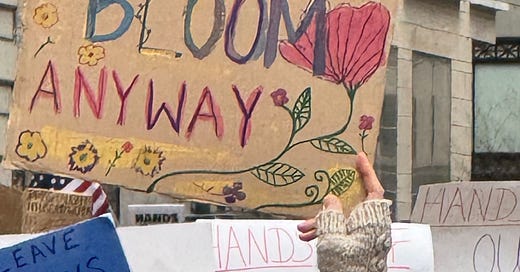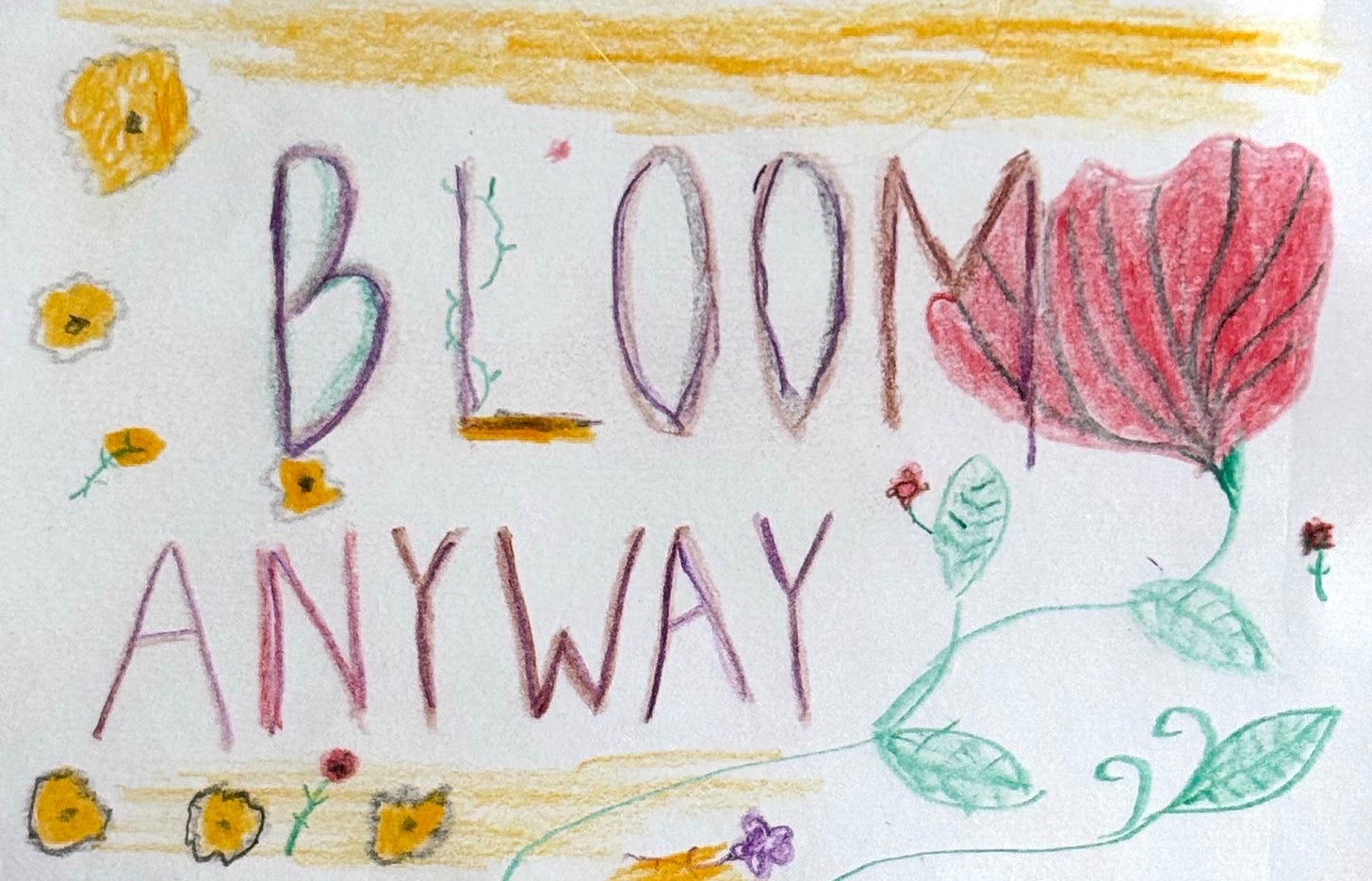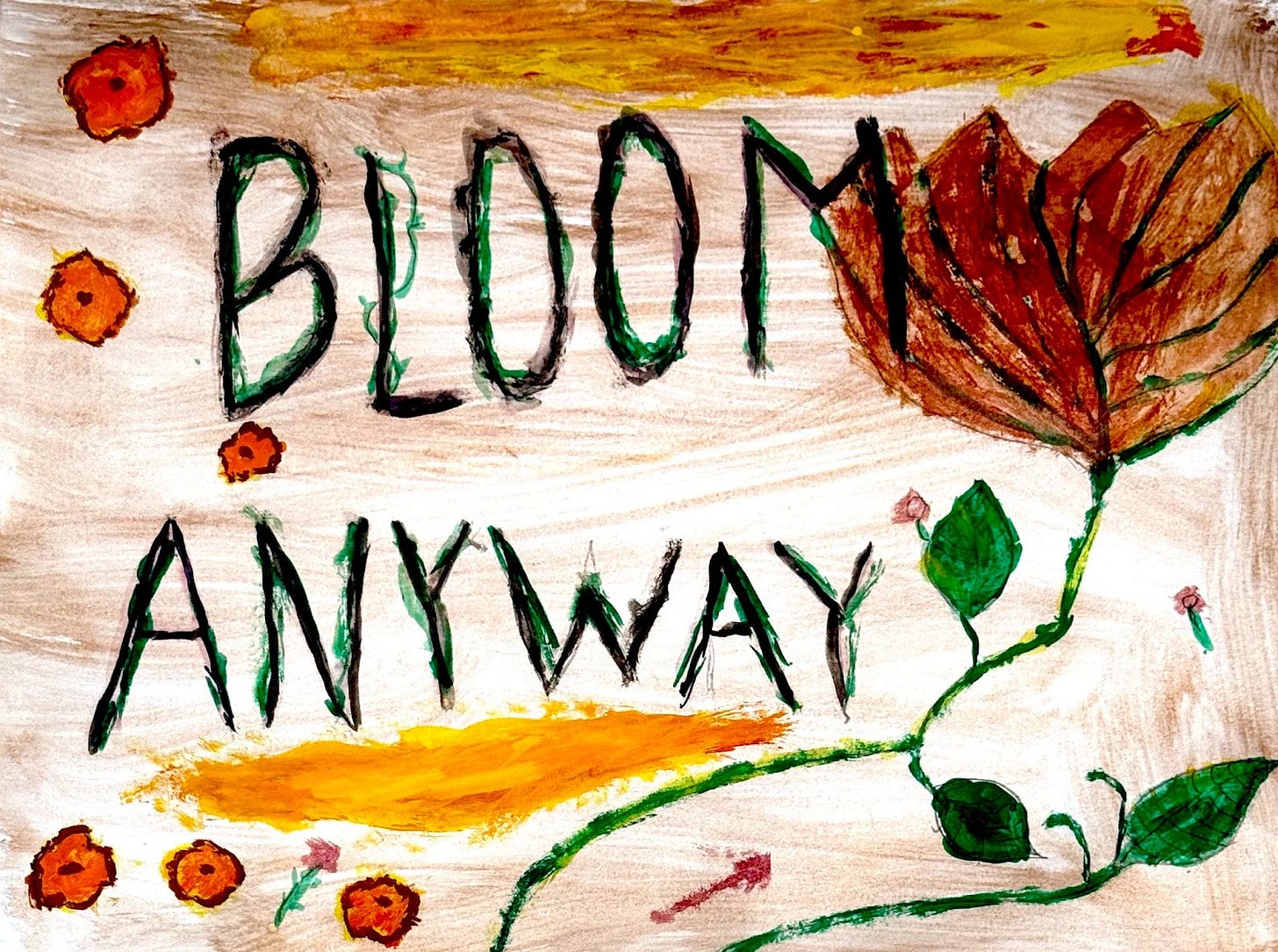1
I hear you or someone like you or if it’s not you, it’s me speaking to myself, saying, “It’s terrible.” Or, “These are awful times. There’s nothing we can do.”
Fortunately, there is an ever-growing group of people who feel otherwise.
It was fittingly the dead of Winter when we inaugurated our former and current President. And now, 113 days later, in spite of all the chaos and destruction, the malevolence and the incompetence, the petty and not-so-petty cruelties and the torrential cascade of lies, Spring has arrived to do its glorious thing.
I don’t know if I’ve ever needed or appreciated Spring more.
I find myself more grateful than ever for the flowers. Tulips, daffodils, the common lilac that makes me more than happy to be common. The forsythia, magnolias, cherry blossoms. The annuals, the perennials, the store-bought, the seed-planted, the re-planted, and especially the wild ones that grow between the cracks in concrete.
Still, it’s hard not to succumb. For too many of us, these are terrible times. But they’re not only terrible.
2
In the spring of 1986, I was in a terrible bind.
I had accepted a position to teach at a summer theater program for high school students at Northwestern University. I’d attended this same life changing program seven years earlier. It had been my dream to one day return as a faculty member and now my dream was coming true.
But soon after I took the teaching job, my teacher, the great Sanford Meisner, surprised a select group of his current students with an offer to return with him to the island of Bequia for a culminating month-long intensive. This was a once-in-lifetime opportunity. However, I had already said “yes” to the job at Northwestern. I couldn’t do both. So I had to Hamlet-it and make the choice between studying with arguably the greatest living acting teacher or endeavor to become a teacher in my own right.
I decided to (try and) teach.
So while I rode for 20+ sleepless hours on a Greyhound bus from NYC’s Port Authority to Chicago, my classmates jetted to Barbados, propeller-planed-it to the island of St. Vincent, and small-boated-it to the magical island of Bequia, where Mr. Meisner was waiting to greet them. And on the night before my new job was to begin, as I unpacked in a hot and humid dorm room in Evanston, Illinois, I was overcome with a debilitating panic. I remember waking up the next morning drenched in sweat, certain of only one thing: I had made the worst decision / biggest mistake of my life. Somewhere in the chaos of my mind, however, I heard my mother’s calming voice saying what she’d often advised me: “Bloom where planted.”
According to the Gospel of Google, “Bloom where you are planted” is credited to Saint Francies de Sales who lived in the late 1500s and early 1600s. So, OK, my mom didn’t come up with the concept, but she not only passed it on, she modeled it.
Fear drove me in those first hours and, in many ways, during the entire five weeks of the program. I needed to up my game or Regret with a capital “R” would follow me the rest of my life. And the thought of that, at twenty-three, was unbearable. No, I’d made my choice and now I needed to make it work.
3
There is so much about growing older that I find difficult to recommend. The failing eyes, the pervasive hairs, ear and nose, the constellation of brown spots that adorn the backs of my hands, the devolution of teeth and gradual gum recession – no one tells you (or if they did, I wasn’t listening) that it’s an ever growing parade of potential horribles. Yes, and … and let’s emphasize the yes, and … there are some exquisite flashes of hard-earned learning, the possibility of a blurt of wisdom … here’s mine for today:
When I can see that a terrible thing is not only terrible, other possibilities become possible. Hope. Hidden beauty. The sudden emergent reveal of a new, maybe only momentary, way forward.
4
That summer of ‘86, in the first playwriting class I ever taught, a male student asked with a disarming (for me) amount of snark, “Mr. Hedges, what if anything have you written?” The truth was I hadn’t written much. I was soon-to-be twenty-four years old and the question from the student was a fair one. But his subtle, searing emphasis on if anything caught me off guard, and I over compensated by saying: “Hmmm. Here’s what I’m gonna do. I’m going back to the dorm tonight, and I’m going to write a play/monologue, and I’m going to rehearse it tomorrow night, and I’m going to perform it at the Faculty Recital this coming Sunday and I’m going to dedicate it to …
I looked right at the student and said, “...you.” I paused for effect, then continued: “This way next week when you walk into class you won’t be able to ask ‘Mr. Hedges, what if anything have you written?’”
By the time I finished speaking, the room had grown eerily quiet. Then the other students started to clap and cheer. At first I felt vindicated. Only later, on the lonely walk back to the dorm, did it hit me – Oh, Peter, why did you say all that?
I had no good answer, other than reckless pride.
Failure to do as I promised would decimate any credibility I presently had, so I stayed up late that night and wrote a monologue that I gave the working title “Going Places with Gary Gilbreath.” Gary was a childhood friend who had moved away in the fourth grade. I always found his last name funny.
Three days before the Faculty Recital, we had to give the actual title of whatever piece we would be performing so that a program could be printed in time. I very much liked the “Going Places” part but was struggling with the Gary-Gilbreath-of-it-all. I turned to the nearest student I could find and tried out a different last name for the character in my monologue. I proposed the name Gary Grape. The student said he liked the alliteration and the last name Grape a lot but he wasn’t so keen on Gary. So I said the first “G” lettered name that came to mind which was Gilbert, and he said Gilbert could work.
It’s a long and (I think) compelling story about how that little monologue eventually morphed and grew into the writing of my first novel and then the eventual film What’s Eating Gilbert Grape. But I’m not going to tell that story. Other than to say that what looked to be the worst, most regrettable decision of my life turned out to be anything but.
That summer I met a myriad of remarkable people who remain meaningful in my life, like one student, Brooke B., who later became my writing teacher. And there are many others who I will never forget, like that group of students who formed a band with me called Mister Amoeba and the Four Spores. (This will be the subject of its own future Substack post.) Most important of all, that summer was the first time I heard the name of a dynamic being who had taught in the same program the previous summer. My fellow teacher/mentor Lynn B. spoke with so much fondness about someone named Susan Bruce that when I met the actual Susan Bruce three years later, I was predisposed to her dazzle. And for the last thirty-two years, I’ve been her lucky husband.
All of that (and more) was made possible because I did my best to do what my mom said to do.
Bloom where planted.
5
But what if you really don’t like where you are?
Like right now, in the early innings of this not-so-fun game of Let’s Destroy Democracy, what if you want to be somewhere, anywhere else? What if you’re like 75 million (and counting) other people who are pretty confident we elected the wrong, small person for the most giantest of jobs?
Answers sometimes arrive indirectly. And sometimes they feel heaven-sent.
That was the case on April 5th at the “Hands Off” March that started at Bryant Park. In previous posts, I’ve written about attending various rallies and marches, about finding comfort there, about finding strength in numbers. The opposition may have the power, but increasingly we have the people, and we have the signs.
Here’s my (so far) all-time-favorite:
Look at the sign. Bask in it. See the details. The way a Magic-markered vine wraps around the vertical “l” in L. The greenish lettering in BLOOM. How the red of the rose repeats in the letters of ANYWAY. And all painted or drawn or colored on a torn piece of cardboard. For my taste, it was a museum-worthy work of art.
I was so captivated by the sign that I did all I could to push through the massive (yes, massive) crowd to reach its maker. I wanted to know everything about the sign – why those two exquisite words when there are so many possible words? And the acquisition of that particular piece of cardboard – and what materials were used - was this their first attempt? Maybe I wanted to say how this felt like a sign my mom might have had made - were she alive. More than anything, I wanted to know everything or at least something more about this sign and the story behind it.
But the more I tried to squeeze through the chanting, marching throng, the sign and its maker/holder got further away, until they were lost to me in a sea of other signs.
You learn a lot about a sign by trying to copy it.
The following Saturday, I spent my evening making my own version.
I did this on a 4 x 6 notecard using colored pencils and Crayola crayons.
Last Saturday night I went 11 x 14 full on with watercolor.
But what was missing? What I wished for more than anything was to hear from the person who made the sign, who carried the sign, and who in so doing changed - no, had bettered me.
Sometimes wishes come true.
“I made this sign in honor of my Grandma Rachel. She died during Covid. She was who I would call whenever times were time tough. She was a good listener. And when I’d finish my dump of worries and fears or my retelling of a setback or of a bad experience … she’d always say, “Bloom Anyway.” I added the flowers because Grandma Rachel loved flowers. And gardening. She taught me how to plant seeds.”
– Sophie, 23, Brooklyn, NY
What a beautiful sentiment from Sophie – if only it were true.
No, I made up Sophie and I made up what she might have said. It was part of a middle-of-the-night burst of inspiration. I was creating a proof-of-concept for an idea that had jolted me awake. It would be called Signs of the Time. The idea was simple, but maybe not easy: Photograph protest signs and then endeavor to learn the personal and passionate stories behind those signs.
It was a kind of Humans of New York but for this Age of Protest.
I shared this idea with some old friends, several new friends, and in a short, few weeks have been privileged to be helped by many of them to “beta test” this concept. Around the country in states like Texas, Pennsylvania, Iowa, Colorado, Washington, and California, we spoke with sign makers and photographed their signs.
Yesterday we started to post. Our goal is to post (at least once a day) a sign and the story behind it. We hope to encourage others to make and carry their own signs and build community, especially for those who can’t take their own posters into the streets. We celebrate the undeniable originality, hand-made beauty and ferocity of purpose. In so doing we hope to shine a light on those most impacted during this fraught moment in our history.
If you like what we are attempting with Signs of the Time, please consider joining us. At the very least, please share it with your people.
You can find us on:
And if what we’re doing is not quite working for you yet, remember Season 1 of Seinfeld. It wasn’t the show it ultimately became. They hadn’t hit their stride. If we haven’t yet, I promise we will.
Regardless, let’s agree on one thing - let’s make the following the next of the 47 Ways Forward:
#16 - Bloom Anyway.
***
Peter Hedges is founding member of Signs of the Time and a proud new member of the Iowa Writer’s Collaborative.






Thank you for this. I needed to hear this- somehow especially today. When anger about this current situation threatens to overwhelm and paralyze me- which is just what they wish to happen- I am reminded that I can access joy, and practice decency and humanity , and be the Light In The World. Thank you for this platform to inspire others to share and know that we are not isolated in a wilderness of hopelessness and helplessness.
As one who often enough feels potted in red clay surroundings, my roots but particularly pistil, really appreciate you and St. Francis this morning.